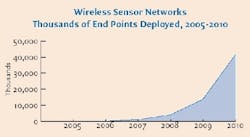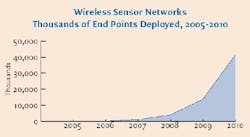Wireless sensor networks market expected to skyrocket
ON World’s study, “Wireless Sensor Networks: Growing Market, Accelerating Demand,” also reports there are many new sensor network opportunities. Besides saving hundreds or thousands of dollars per hour on labor for installation, wireless’ advantages are that users can install sensor networking and monitoring capabilities in places where they couldn’t before, and perform measurements that would be prohibitively expensive with hardwiring. The study found that wireless promises to allow faster reconfiguration of plant-floor networks as applications change. It also states that many potential sensor applications aren’t possible today due to remote and/or hazardous environments.
- A strong need for more remote sensor monitoring of equipment, processes, groundwater, tanks, pipelines etc. WSNs are likely to be the only option for most of these applications because many presently are manually operated, which means they’re usually inefficient and expensive. If WSNs aren’t implemented, ON World says companies risk potential unplanned failures that reportedly could reach $1 million per day and/or be subject to regulatory fines. Even continuing manual maintenance reportedly wastes tens of thousands of dollars annually by replacing equipment that doesn’t need to be replaced.
- The six to 10 largest oil and gas firms are all familiar with WSNs, and most believe they will likely adopt it for many applications within the next 24 months.
- There are thousands of likely WSN applications outside the standard control and automation processes, which also represents an opportunity for sensor and RFID manufacturers, OEMs and startups.
- Unlicensed wireless radios are one of the fastest growing technologies in the industrial sector. ON World estimates that 10-12% of petroleum companies use some unlicensed spread spectrum radio, mostly for Wide Area Wireless SCADA applications. All companies using wireless technologies are interested in learning more about how to implement WSN.
- Nearly all oil and gas companies use wireless technologies for field monitoring and automation applications, such as pipeline operation and wellhead monitoring. Most of these are licensed wireless technologies that are outdated, expensive and unscalable.
The report also identified several limits presently restricting WSN implementation. These limits include:
- Leading industrial automation OEMs are investigating WSNs, but more slowly than ON World says it initially predicted. Their reluctance to embrace wireless sensor networking is likely due to a lack of expertise and a desire not to be dependent on too-strong or too-weak partners. They’re also likely concerned how WSN will affect their core offerings, and need to develop new business practices and markets, as well as technology strategies to support them. ON World adds it recommends the firms move now because their competitors, such as Honeywell, Emerson Process Management, Siemens, Schneider Electric, and Mitsubishi, will be driving and leading new markets with WSN solutions that save users time and money.
- Standards uncertainty. Standards will help ease the OEM reticence, but there is concern that ZigBee might not be appropriate for many types of industrial monitoring, control and especially automation. Mostly, this is a result of the ZigBee Alliance’s present focus on applications most suited to commercial building/home automation, and other companies pushing their own proprietary solutions in the meantime. Several successful pilots of 100+ IEEE 802.15.4 nodes have been demonstrated in harsh environmental settings.
- Much more end user education required on the benefits of WSN. Those that use WANs only, mostly smaller exploration and production companies, are not yet familiar with WSNs.
- There is much room for technology improvement including installation, network management, power consumption reduction and/or lifetime power sources and application development.


